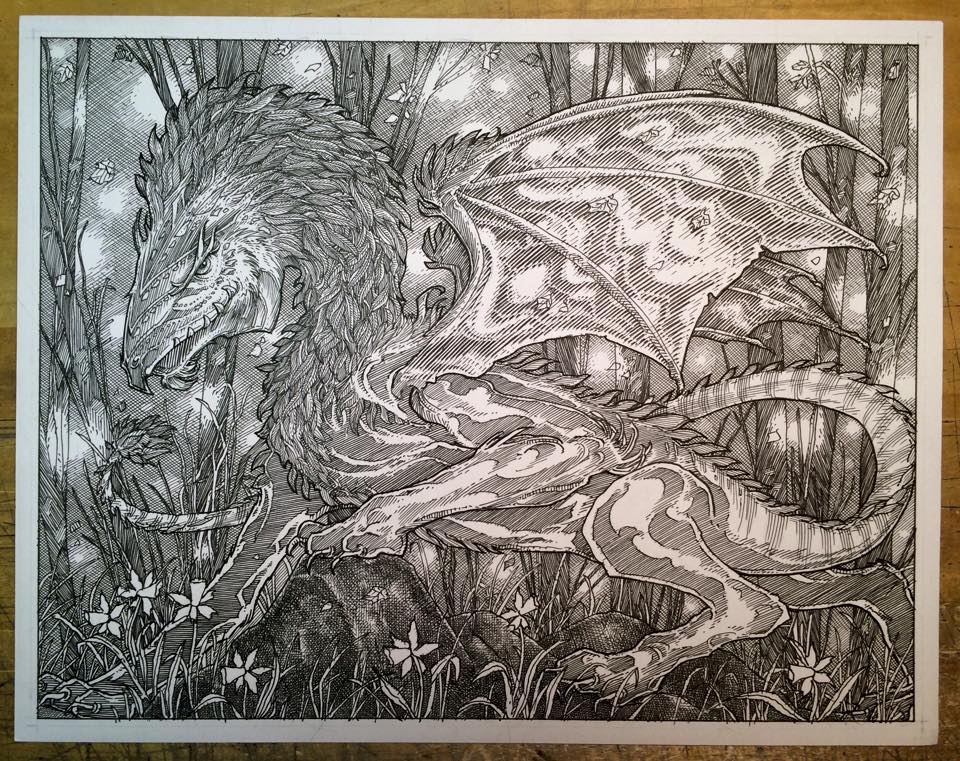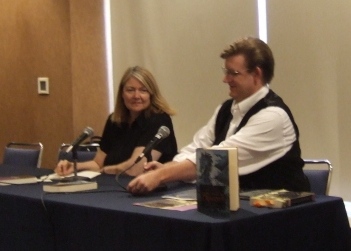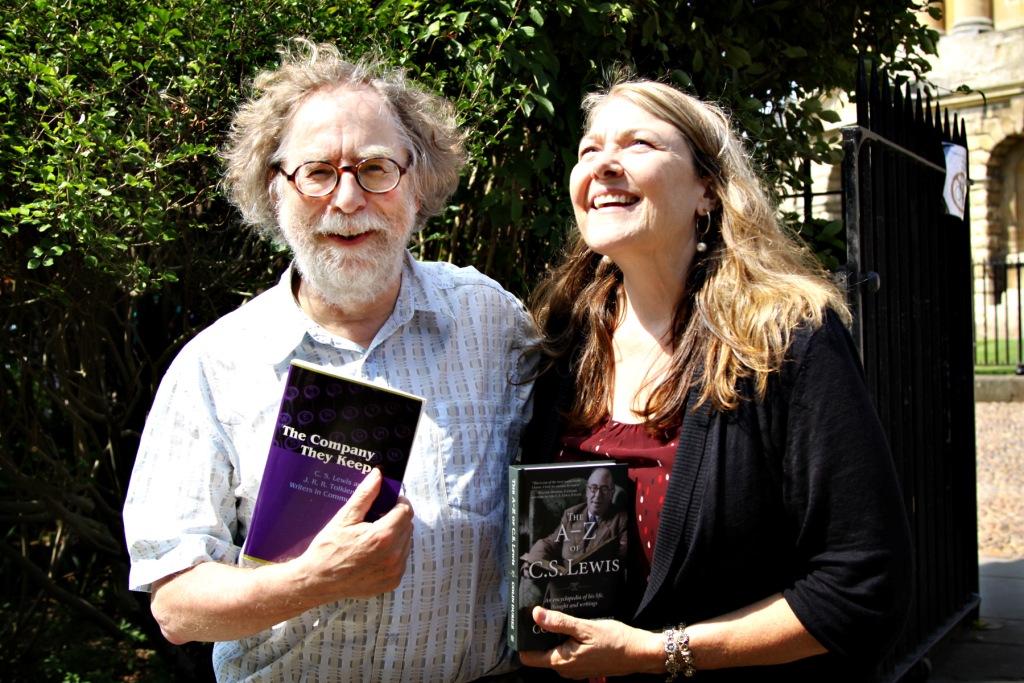Bandersnatch: C.S. Lewis, J.R.R. Tolkien, and the Creative Collaboration of the Inklings by Diana Pavlac Glyer will be released November 30 in paper and can be preordered at Amazon.
The Bandersnatch title comes from C.S. Lewis’ famous denial, “No one ever influenced Tolkien — you might as well try to influence a bandersnatch!”
Yet influence there was, between all the members of the legendary writers’ group.
Bandersnatch is adapted from Diana’s The Company They Keep, a 2008 nominee for the Best Related Work Hugo. It is designed to reach a broader audience, and new chapters give practical tips on doing what the Inklings did.
Her book —
offers an inside look at the Inklings of Oxford, and a seat at their table at the Eagle and Child pub. It shows how encouragement and criticism made all the difference in The Lord of the Rings, The Chronicles of Narnia, and dozens of other books written by the members of their circle. You’ll learn what made these writers tick, and more: inspired by their example, you’ll discover how collaboration can help your own creative process and lead to genius breakthroughs in whatever work you do.
James Artimus Owen has done a suite of illustrations, including this one of the Bandersnatch itself, one of 11 drawings commissioned for the book.
James is currently under contract with Kent State University Press to produce a coloring book based on the illustrations for this book. It might be the first time ever that a highly respected University press is issuing a coloring book, much less a coloring book of images drawn by a leading genre artist.
Diana and James met when they were both guests of honor at Mythcon 40, chaired by Sarah Beach.
James Artimus Owen is the author and illustrator of the Starchild graphic novel, the Mythworld series of novels, the bestselling The Chronicles of the Imaginarium Geographica, and the forthcoming series Fool’s Hollow. He has also written the inspirational nonfiction trilogy The Meditations and the illustrator/designer of The Hundred Books Project, a series that showcases some of the greatest books ever published. He works in the Coppervale Studio, a 14,000 square-foot, century-old restored church in Northeastern Arizona.
Get updates about the book from the Bandersnatch Facebook page.
More Inklings news: Diana Glyer and Colin Duriez, another well-known scholar, were recently interviewed about their work on the Inklings by Lancia E. Smith. (With terrific photos of them, too.) Glyer and Duriez are going to be featured speakers at the 10th Annual Frances White Ewbank Colloquium on C. S. Lewis and Friends at Taylor University on June 2-5, 2016. The hosts’ Facebook page has more information.
Discover more from File 770
Subscribe to get the latest posts sent to your email.




That sounds interesting. I have pre-ordered the book!
Glyer, Glyer, that sounds vaguely familiar… 🙂
So things have finally settled down chez Glyer for Diana to tiptoe back in? Sorry about scaring her off like that. Tell her we’ve saved a slice of pizza and a ginger ale for her.
While Owen’s illustration is apt and certainly pretty, I much prefer Larry Niven’s Bandersnatchi…
Love books by people who weren’t involved, weren’t around, were not even friends with the actual participants who believe they know better than the participants themselves what went on and who influenced who.
That kind of hubris was regarded as dangerous by the ancients.
Have you read Diana’s earlier book on the same subject? If not, “hubris” is a good term for such unwarranted dismissal. If you do read it, you’ll see solid scholarship based on what the Inklings actually did and said, and which puts their own statements about it in context. There’s no arrogant claims of knowing them better than they did, and no rickety structure of what they “surely” or “must have” thought or did, of the kind that spoils much cheap psychoanalyzing.
It’s true, Glyer’s earlier book (The Company They Keep) was viewed by some who hadn’t yet read it as claiming to know better than the Inklings themselves, but it ultimately reversed the view promulgated by some of the individual Inklings by presenting the flip-side of the coin of which most of us were oblivious because we weren’t aware of the articles and attitude which surrounded the Inklings in the early days of their gatherings. Context does, indeed, make a huge difference: we all know intellectually that the earth orbits the sun and yet we say “the sun rose this morning” because it’s vernacular and it reflects our daily perspective – we’re living on the earth and thus too close to see our own movement around Sol.
In a similar way, the Inklings couldn’t effectively observe themselves because they were too busy being themselves. It’s actually a fantasy conversation I would love to have: to present The Company They Keep to CSL or JRRT or Major Lewis and examine the patterns of evidence; I think it both amuse and amaze all of the Inklings.
So, in that sense, the most accurate view truly is from the outside, with some distance, because the evidence supporting “influence” is overwhelming.
” reversed the view promulgated by some of the individual Inklings by presenting the flip-side of the coin of which most of us were oblivious because we weren’t aware of the articles and attitude which surrounded the Inklings in the early days of their gatherings”
Here, let me put some words in your head for you “Yes I understand that you are an Oxford Professor in the old sense of the word, but I am here to tell you that you are completely wrong about what you think of your own work and the works of your friends, also intellectuals in the old sense of the word.” Like I said, hubris. Had you been around, you would have easily derived Newton’s Laws AND the flaws with them. Not buying it.
Thanks for trolling by, Tim. As that scholar Monty Python says, mere contradiction is not an argument.
Steven H Silver’s review of her earlier Inklings book distills the essence of her case for influence.
Tim paraphrased: ” I am here to tell you that you are completely wrong about what you think of your own work and the works of your friends.”
Oh, Tim. That’s not what Diana’s book says at all. What Lynn wrote about it is, I regret to say, misleading out of context, and won’t make sense unless you read the book she’s talking about. But it does go to prove her original point: context is everything.
As you should be able to see from Steve Silver’s review, the context is one of understanding what “influence” actually means and how it expresses itself. There’s really no contradiction between the viewpoints if understood properly. What doesn’t help is mere truculent denial.
I wonder how this idea of dismissing an argument because someone has no direct experience of the events they’re talking about matches up with dismissing an argument without ever having read the book.
If history is written by the participants, and only ever the participants, who then writes the criticism?
Actually, I am deciding if I want to read the book, based on reviews of the book. What I am reading in the reviews is not promising, given that the reviews are positive and I am still getting a bad vibe. Last time I read a review of Tolkien, they were comparing the ring to the bomb, and I put it aside in disgust, given that the Hobbit was written long before the bomb was conceived.
And the last review I read of Lewis was by an anti-Christian bigot….so I am pretty careful what I shell out money for nowadays.
But the English/Drama teacher I had in High School for 11th and 12th grade had me get up and give an oral review of LotR in 1974…..and said I did a really good job…..looking back, she should have added “for a high school senior”, as I shudder with shame at all the nuances I missed….and by my senior year I had read the books 3 times. And yes, those who go back and look at history “from our current perspective”, usually miss completely the true history….because they cannot separate themselves from their own perspective…….which has yet to stand the test of time.
Something else that may help your decision — the introduction to her first Inklings book, The Company They Keep, is online here.
Tim, the books you describe are exactly the kind of foolishness that you will not find here. There are no allegorical readings, there are no revelations of secret agendas, there is no claim that the Inklings were lying about themselves, there is only the putting of plain facts together in a new construction – a construction based on deep scholarly study of how writers’ and other shared-interest groups actually work – that has, I think, convinced just about everybody who’s read it. There were two previous theses about the Inklings’ inter-relation: that they had the same agenda and shared ideas and themes, and that they were just friends with nothing whatever in common. Both of these are wrong, but Diana’s book shows the elements of truth in both of them. I’ve read a lot of nonsense about Lewis and Tolkien. This isn’t nonsense.
Mike, I am getting a 404 error on that link for some reason.
Hm. Try this link — http://www.dianaglyer.com/company-keep/ and scroll down to “Read the introduction (PDF).”
Tim, I suspect that if you enjoy scholarly works (NOT dry scholarly but very interesting, very well-researched, and with great footnotes – don’t miss the footnotes) and you find Tolkien interesting as a person (not simply as the author of a book you like a lot), you will probably find The Company They Keep well worth the effort. Context really is a major issue here and obviously I don’t do it justice in a few sentences.
Pingback: Tolkien Collector's Guide - News » "Bandersnatch: C.S. Lewis, J.R.R. Tolkien, and the Creative Collaboration of the Inklings" by Diana Pavlac Glyer
Isn’t Owen Barfield still alive?
Checked and he passed in December 1997.